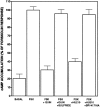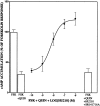Concurrent stimulation of cannabinoid CB1 and dopamine D2 receptors augments cAMP accumulation in striatal neurons: evidence for a Gs linkage to the CB1 receptor
- PMID: 9204917
- PMCID: PMC6793808
- DOI: 10.1523/JNEUROSCI.17-14-05327.1997
Concurrent stimulation of cannabinoid CB1 and dopamine D2 receptors augments cAMP accumulation in striatal neurons: evidence for a Gs linkage to the CB1 receptor
Abstract
Cannabinoids act at the CB1 receptor to inhibit adenylate cyclase activity via a pertussis toxin-sensitive G-protein. Within the striatum, CB1 receptors have been shown to be localized on the same neurons as Gi-coupled dopamine D2 receptors. In this study we have examined the interactions of CB1 and D2 receptors on adenylate cyclase. In striatal neurons in primary culture, both the CB1 receptor agonist [3-(1, 1-dimethylheptyl)-11-hydroxy-Delta8tetrahydrocannabinol] (HU210) and the D2 receptor agonist quinpirole inhibited forskolin-stimulated cAMP accumulation when applied separately. In contrast, HU210 and quinpirole in combination augmented cAMP accumulation. This augmentation was blocked by the CB1 receptor antagonist SR141716A or the D2 antagonist sulpride. Pertussis toxin treatment of striatal neurons prevented the inhibition of cAMP accumulation by D2 receptors but unmasked a cannabinoid receptor-mediated stimulatory effect on cAMP accumulation. The cannabinoid receptor-stimulated accumulation of cAMP was blocked in a concentration-dependent manner by SR141716A, suggesting that the response was regulated through the CB1 receptor. Similar augmentation of cAMP accumulation after pertussis toxin treatment was observed in Chinese hamster ovary (CHO) cells transfected with, and stably expressing, the CB1 receptor. This stimulation of cAMP was not Ca2+-sensitive and was unaffected by a range of protein kinase inhibitors. Treatment of the pertussis toxin-treated cells with cholera toxin before CB1 receptor activation amplified the stimulatory pathway, suggesting that this response was mediated through a Gs-type G-protein. Stimulation of cAMP accumulation was not observed after pertussis toxin treatment of CHO cells expressing the human CB2 receptor, suggesting that this novel signaling pathway is unique to the cannabinoid CB1 receptor.
Figures




References
-
- Barovsky K, Brooker G. Forskolin potentiation of cholera toxin-stimulated cyclic-AMP accumulation in intact C6–2B cells. Evidence for enhanced Gs-C coupling. Mol Pharmacol. 1985;28:502–507. - PubMed
-
- Beckstead RM, Cruz CJ. Striatal axons to the globus pallidus entopenduncular nucleus and substantia nigra come mainly from separate cell populations in cat. Neuroscience. 1986;19:147–158. - PubMed
-
- Beckstead RM, Kearsey KS. Immunohistochemical demonstration of differential substance P-, met-enkephalin- and glutamic acid decarboxylase-containing cell body and axon distributions in the corpus striatum of the cat. J Comp Neurol. 1985;232:481–498. - PubMed
-
- Bidaut-Russell M, Howlett A. Cannabinoid receptor-regulated cyclic AMP accumulation in the rat striatum. J Neurochem. 1991;57:1769–1773. - PubMed
-
- Chabre O, Conklin BR, Brandon S, Bourne HR, Limbird LE. Coupling of the α2A-adrenergic receptor to multiple G-proteins. A simple approach for estimating receptor-G-protein coupling efficiency in a transient expression system. J Biol Chem. 1994;269:5730–5734. - PubMed
Publication types
MeSH terms
Substances
LinkOut - more resources
Full Text Sources
Other Literature Sources
Medical
Molecular Biology Databases
Miscellaneous
